Still life Dutch kitchen 17 18 paintings. Still life in Holland in the 17th century
Dutch still life nadikhaє i modern artists At its right time, it was like a piercing, as if it hadn't been overlooked. The Dutch still life of tsikaviy is not only familiar to painting, I ask you to enjoy the pictures and history.
The Dutch still life mav kilka is straightforward, for example, the great popularity of the image of game and the beaten bird was put up to the category "Mislivska trophies"
Willem Calf has made a trip to Paris, the first to settle in Amsterdam. A picture of a zoserezhena near a wine cell and showing three oranges and lemons. Licorice and sour fruits are allowed, so that the look will become more peaceful. A lot of orange peelings, one addition of orange and lemon juice to wine for drinking purposes.
The picture shows a candle, a perch, a cell of wine, a book of books, one glass, and a pair of eyepieces. A picture of a viglyadє yak combination of decilkoh lesser still lifes. In the foreground, right-handed, є a number of musical instruments. The stench of lying with a handful of armor and books. More books are shown on the table, as well as a statue of a gipsy, deyaki kistki, a skull and development materials artist. It is clear from the skulls and the cysts, which is a picture about shvidkoplinnist, for example Vanita. Years of birth and vigor, the oil lamp is carried until the hour of the Plain, at that time the musical instruments symbolize the ephemeral nature of music.
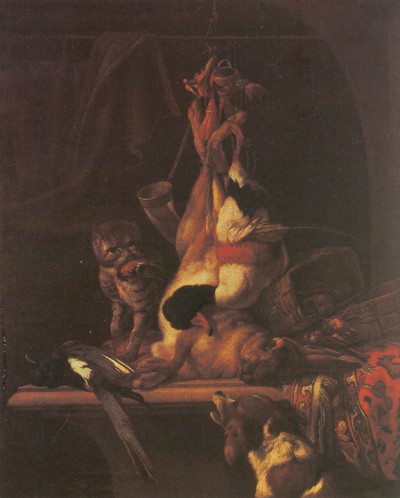 Melchior de Hondecutera "Mislivska Trophies"
Melchior de Hondecutera "Mislivska Trophies"
Another direct Dutch still life of "Snidanok" and "Dessert", the image of cooked food, but it is more reasonable, often in the pictures you can eat seafood, poultry, a lot of fruit.
Vanita is referred to as the word Marnoslavstvo and to shvidkoplinnosti. Dutch paintings of the eighteenth century are often symbols of shvidkoplinnosti, especially still life. Skulls, snowy years, extinguished candles and additional items are reported until the beginning of the day. Pictures of vanitas poklikanі nagadati to the glances about those, like a short life and how you are guilty of living with the proper urahuvannya of the laws of God. Tse is one of the most early still lifes klosh. The artist is Harlem, who gave the invisible presence of familiar speeches. Here is the skull, the scrolling of the roymer with shvidkoplinnymi thoughts, the lamp is stitched and the attributes of the writer to inform about those who are worldly zusill in the end bag of the marnie.
 Baltazar VAN DER AST "Tarilka with fruits and shells" 1 630 g
Baltazar VAN DER AST "Tarilka with fruits and shells" 1 630 g
At the same time the Dutch still life of the 17th century "Kviti and Frukti", which could be images at once on one picture, may be seen in the pictures of the images of coma, often blizzards.
A lot of still lifes were repeating repeated symbols of knowledge and knowledge, and the Dutch are most beautifully seen for the whole of symbolism. Through the protocols, symbolism is widely used in paintings in 17 centuries. Vanitas - the tse of terms, otrimaniy from the Book of the Prophet in the Old Zavit, yaka repaired: "Marnoslavstvo suєt, all suєta." The paintings by Vanitas were responsible for the lack of confidence in life and the Marnoslawism of human creativity.
The stench sounded from the happy glances at the sight of the happy and aspiring to the maybut. Yak can be seen from the bagatokh Dutch paintings, often є zanadto stiglі fruits, often lemon or іnshі citrus fruits, which symbolize licorice and sour life, as well as the time-consuming nature of life. The open spaces in the parts also symbolize the tendency of the nature of life. Life can end like a piece of fruit. Skulls are also rewound in the Dutch mystery of the 17th century, which symbolizes our team's time here on earth.
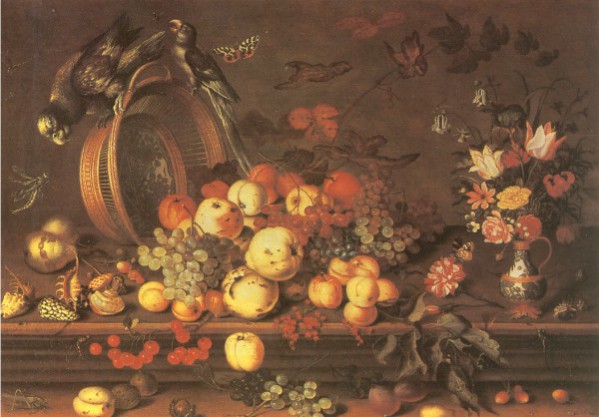 Baltazar VAN DER AST "Still life with fruits"
Baltazar VAN DER AST "Still life with fruits"
The Dutch still life is symbolic of meaning, it’s not just an image of products, quotes and so on. The main idea of the yak was dominating the Dutch still life of that hour — the greatness of the earthly earth and the inevitability of death. Behind the additional symbolic objects such as: a year, fading trojands, a clue, artists talked about those who are not familiar in the whole world. and the like, it's a pity, in bitchy painting the symbolism is embedded in the painting and it is impossible to explain the meaning of all the symbols in the Dutch painting of the 17th century. In those distant hours, the Dutch evenings got into the booth of the master of the still life, they looked at it and discussed the meaning of that symbol: wines of the laurel wines - the pureness of glory, coins - Marnoslove, etc.
Svіzhі svіzhi and the year of the year will be victorious, so as to symbolize and nagaduvati to us, that our life will end even early. Nagaduєmo here about clearer, an hour to fly. At that hour, the pictures of Vanita fondled our mortality, the stench also fostered Marnoslauka in human endeavor. The prosperity of їzhі in a still life can be a symbol of rose and wealth, ala at the same hour subordinate Vanita. Food is not trivial, it’s not life. Dutch still lifes with symbols of rose and wealth are called protonkovim still lifes, written in a Dutch word, pronkta, which means "boast".
 Jan Davids de Hem
Jan Davids de Hem  Jan Davids de Hem
Jan Davids de Hem
I respect that in the paintings of Dutch artists of the 17th century, the apartments are built from nature, but it’s not like this, but also the compositions are built from the growing roses and fruitful during the winter. and so on, I’ll get it, because then Vikoristov have been developing a lot of artists in their still lifes. ...
Іnsha humanity morality in still life. Oysters appear in still lifes, the stench is an aphrodisiac and symbolizes sexual satisfaction. Often there are no oysters in still lifes of great sexual connotations. The most important symbols of wealth and roses are wine and cups, from which wines to live. I know the stench of being vicious, showing the earthly contentment.
The residual analysis of vanity paintings is one and two meanings, explained here. The picture is moral. A collection of images of the time-consuming nature of life, and even to us to guess, that the earthly contentedness is not guilty of being important. Symbols of the proverb, shou of the earth, material speech does not mean meaning, but the symbols of Vanita give hope for life beyond the grave. Vazhaliya, how the paintings of vanitas spontaneously gaze in the unwillingness of the earthly material speeches and zoosereditsya on the eternal life beyond the grave.
Quite still lifes in Holland became popular among the nobles and nobles, in the 17th century skin quilt still life in Holland there were tulips in the presence, at that time the country was experiencing a boom of tulips. For the cybulin of a flower tulip, they could have laid the buds, the cultivation of tulips was often favored by the aristocrats. created in the still lifes of Dutch artists.
Їх mark bulo povidomiti yakus gіdnu abo transcendental morality. Dzherelo: Museum of the Ringling Klas associate professor. The obvious realism of the bagatioh of the Dutch arts can be Omanlivian. For example, a rich set of still lifes show a combination of colors, which does not unfold at the same hour to rock. By an analogous rank, the generous Christmastide tables are set up in a partly independent way, interrupted in the middle. І landscapes can create an encouraging light for a new svitanka, or a dark threat of a storm is approaching.
 Jan Davids de Hem
Jan Davids de Hem  Jan Davids de Hem
Jan Davids de Hem
The Dutch still life of the XVI-XVII capital is a kind of intellectual graffiti, in which glance there are signs of singing. Those who were easily read by the participants, this year's intelligence is not for everyone and not expected. I will explain what the images of objects by artists mean
The name of the emotional space, solidity, texture and light often take on the role of a memorable sea - nagaduvannya about those who live life and who God is good, ale of yo judgment suvoro. To that, sleepy, or gloomy landscapes can mean, apparently, obitsyanka or a threat. Clear bouquets can be made to look at people, as well as to help people, as and everything else in the world, inevitably guilty to die. By an analogous rank, uncompleted banquets can be supported by unimportance in life, or serve as a call to peace.
Promotion of unique Dutch relish. Flanders, by the very nature of Belgium, was a former region closer to Catholic France and before the Vladyka of Spain, became a Catholic and a royal. Vivtar, ship portraits and allegories, to glorify the monarchs, to include rich Flemish paintings in the gallery's collection. Flemish artists like Rubens and Van Dyck yaskravimy quotes and we live with a roach.
Jean Calvin Jean Calvin(1509-1564) - the reformer of the church and the forerunner of the same pro-testantism. The basis of the Calvinist church is based on the so-called congregation - autonomous food-making, fermented by a pastor, diakon and old people, vibranized from the laity. Calvinism was still popular in the Netherlands in the 16th century. vchiv, scho povsyakdenni speeches may be sympathetic to meanings, and for all images a moral lesson is guilty. Objects, taken in still life, are rich in meaning: they were overpowered by a general, religious, or even with a pidtext. For example, oysters were honored as an erotic symbol, and it was obvious to the contenders: oysters stimulate sexual potency in any way, that Venus, the goddess of love, was born from the crustacean provinces. On one side, the oysters were stretched over the world’s spokusi, on the other side, the shell opened the soul, I’m ready to leave the house, so that it’s obzyatunok. Strict rules, how to read a still life, didn’t exist, and at the glances in the canvas, the same symbols, like wanting bachiti, didn’t exist. Until then, it’s impossible to forget that a leather object is part of the composition and can be read in a simple way - from the context of a hundred and from the backward still life.
Visitors from Flanders, from the lower regions of the country, closer to the Protestant Nationalities and Great Britain, were angry in the United Provinces. The Tsia Confederation, who was called "Holland" for hiring a provincial province, became a republic, in the main population of the Calvinists.
The early Protestants respected that they would love idolatry. Kerovan princes only by name, the Dutch drew their leaders. To that, without church or court patronage, the artists turned to nature i haunted life on the subject. First, in the context of Flemish painting, the Dutch mystery play vicariously more balanced compositions, between palates and more pure light.
quilt still life
Until the 18th century, a bouquet of quotes, as a rule, symbolizing the transience, and even earthly joy, so it is by itself, as the beauty of quotes. The symbolism of plants is especially foldable and ambiguous, and the perceptions of the senses added to the popular in Europe XVI-XVII century of the book the emblematic, de alegorical illustrations and devizi supervised by explanatory texts. Quite a few compositions are not easy to interpret: one and the same card is without meaning, one is directly opposed to others. For example, the daffodil has thrown itself into self-sacrifice and immediately entered into the symbol of the Mother of God. In still life, as a rule, there was an insult to the meaning of the image, and in the eyes of the vilny vy-brother, one of two messages, or even one.
However, the hard and fast line is not the same as the Dutch from the Flemish styles. Most popular places two countries - Amsterdam in the Netherlands and Antwerp in Belgium - were all ninety miles away, one to one. Moreover, in seven Dutch provinces, all the main cultural centers lay for a stretch one day, one after one, on horseback.
Malyovniche image of creatures is visible to the sight of reality. In fact, a rich Dutch still life є large-scale manifestations of real objects, like the stench of imagining. Tsei kar'єr chimerically includes in itself a home pivnya, a wild hare and a chicken and decilkokh sleeping birds. In addition, hanging from the cords are two red oxamite hoods, which are victorious for the preparation of Mislivska falcons. One sign of life is a fly, attracted to the blood on the crest of the pivnya.
Quote compositions were often supplemented with fruits, other objects, and images of creatures. The images caught the main idea of the work, the motif of the shvidkoplinnost, v'yanennya, the shimmering of all earthly and intangible garniness.
Jan Davids de Hem. Apartments in vases. Mіzh 1606 і 1684 rock State HermitageIn the picture of Jan Davids de Hem Jan Davids de Hem(1606-1684) - Dutch artist, visualized with his own small still lifes. for the basics of the vase, the artist depicting the semblance of willpower: ziv'yali and evil quits, peels and dried pea pods have dried up. Axis ravlik - won the association with the soul of a sinner Among the few such negative images are reptiles and amphibians (lizards, toads), as well as caterpillars, mish, flies and other life that ply on the ground or live in breeds.... At the center of bouquets of bachimo, the will of modesty and purity: polovі kіti, Violets and forget-me-nots. Їх are surrounded by tulips, as they symbolize beauty in a lack of eyes, marnotratism (cultivation of tulips was held in Holland by one of the most important days to take and is not cheap); Written-ni trojandi and poppies, how to guess about the lack of communication in life. Complement the composition with two great quotations, showing a positive meaning. Blue iris will be able to help you get rid of the garlic. Red poppy, which is traditionally associated with sleep and death, through my own morning rose in a bouquet, changing the truck: here wine means the sacrifice of Christ's Victory Even in Serednyovichya, I was in love, and the poppies were growing on the ground, with the grown blood of Christ.... The Іnshi symbols of the salvation are the whole spikelets, and the snowstorm, sitting on the stems, will help the soul to die.
Claims in tіnі for the silver buckle іgroviy bags, on the marmur p'єdestalі there is a classic basselєf. At that hour, yak nimfi marvel, the goddess of love, Diana, breeze with water on Actaeon, a deadly mischief, like a zdivuvav banya. In punishment for diane bailing, Actaeon sprouts deer horns and will be killed by his dogs.
Van YELSTA, who worked in Paris and Florence in front of settlements in Amsterdam, being one of the first still lifes, to create some trophies. Yah miracles іluzії khutr, pіr'ya and flesh became the main precedent for the old French, British and American sports still lifes.
 Jan Bauman. Apartments, fruits and mavpa. First half of the 17th century History and Art Museum
Jan Bauman. Apartments, fruits and mavpa. First half of the 17th century History and Art Museum Painting by Jan Bauman Jan (Jean-Jacques) Bauman(1601-1653) - living-rewriting, master of still life. Alive and pratsyuvav at Nimechchina and Netherlands."Kviti, Fruits and Mavpa" is a good butt of the media-words of richness and ambiguity to still life and objects in new. At first glance, the day of the roselin and the creature to be built vypadkovim. For the sake of justice, the still life is probably about the versatility of life and the depth of the earthly life. Skin images are the subject of a translucent idea: the rabbit and the lizard, in this particular type, indicate the mortality of all earthly; a tulip, lying on a bowl of fruits, symbolizing a shvidke v'yanennya; shells, spread out on the table, stretch for an unreasonable waste of pennies In Holland of the 17th century, the collection of the Dikov-Nok family, including shells, is even more popular.; and mavpa with a peach will add to the original sin and depravity. From your side, a blizzard is bursting and fruits: grapes, apples, peaches and pears - it seems about the immortality of the soul and the cauldron of Christ's sacrifice. On the іnshom, alegorical rіvnі represented in the picture, fruits, fruits, apartments and creatures mean the chotiri elements: shells and ravliki - water; metelik - povitrya; fruit і kiti - earth; mavpa - fire.
Richka Maas Holland passes through France and Belgium, de von is seen in the yak "Maas". At the exchanged view of Albert Kuyp over the Maasu arm in Dordrecht, the docks, bugles and drums are jammed, fanfare sounds, and fireworks are fired. Tsia is a great sleepy composition specially for one figurine: a young lady, who stands in a chapel with a great ship. On the anchorage ships, there is a wedge-like mass, which is in charge of new, as well as actions of the line of falsification. Your head is lying right in front of the horizon, and your head is black and white, and you are drawn sharply against the very white area of the picture, the rank fog on a distant birch tree.
Still life in myasniy kramnitsa
 Peter Artsen. Myasna shop, or Kitchen with a scene flowing into Egypt. 1551 rik North Carolina Museum of Art
Peter Artsen. Myasna shop, or Kitchen with a scene flowing into Egypt. 1551 rik North Carolina Museum of Art The image of the meat shop is traditionally tied with the idea of physical life, the personification of the elements of the earth, as well as with the charm. In the picture of Peter Artsen Peter Artsen ( 1508-1575) - Dutch artist, also vіdomy yak Peter Long. Sered yogo robot - genre scenes on the Evangelical plot, as well as the image-nya rinkiv and kramnits. Mayzhe entire space of the loan breaks into new styles. Mi bachimo bezlich species of meat: hammered in a bird and chipped carcasses, liver and shin, bones and cowbass. The images symbolize immoderation, feistiness and cunningness to the fleshly satisfaction. Now I will be brutally respectful to the background. On the left side of the picture at the window opening is a primi-puppy of the Evangelian scene flowing into Egypt, as a sharp contrast to the still life in the foreground. Diva Marya is simple, the rest of the kussen hliba evil divchintsi. It is splendid, how vіkno roztashovane over the strava, de chrest-navkhrest (symbol of rozp'yattya) to lie dvі ribi - a symbol of Christianity and Christ. On the right in the glybin there is a tavern. At the table bіlya vognyu sit a cheerful company, vipivaє and іt oysters, like, like, memory, associate for a reason. The entrustment from the table to hang the carcass rose, as in order to prevent the gates of death and the quickness of earthly joys. The butcher in chervon_y sorochtsі razbavlya wine with water. The scene is echoing the main ideas of still life and the barking to the Parable about the prodigal sin Zgadaimo, in the Proverbs about the prodigal blue, there are plots. One of them informed about a young man, like, having obliterated his daddy's mauettes, having sold everything and having lowered pennies on a racy life.... A scene in a tavern, so it’s like a butcher’s meat shop, and it’s just like talking about a do-it-yourself, rosaceous life, a cunningness to earthly malnourishment, we take it for til, a little bitter for the soul. At the scene in Egypt, the heroes are practically turned to look with their backs: the stench is removed in all the pictures, given from the meat shop. This is a metaphor in the course of the discord of life, more of the sentiments of joy. Vidmova from them is one of the ways to vryatuvat the soul.
Oskilki win to wear a belt in the quits of the place Dordrecht chervonim and bilim, it can be a ceremonial festival and, imovirno, є the patron, who instructed Cape to document the history of the story. The whole subordinate portrait on horseback is unique in the Dutch art and in Europe of the eighteenth century, for that reason, if you need it, the boules are reserved for the surrounding monarchs. Couple, ymovirno, cholovik and squad. Imovirno, Sitter wanted more respect for himself, so Kuip had rebuilt and simplified the composition.
For example, the burdock growths are evil, for example, to take care of several dogs, which are now overfarmed. Repeating loving motives, Kuip repeating the white horse of ice in his Vershniks and shepherds with great horned thinness. The picture, which clearly depicts a love, was thrown into the ruins of Nimetsian castles and monasteries, like Kuip throwing an hour of travel along the Rhine River.
Still life in ribniy kramnitsa
Ribbon still life - the whole alegory of the water element. This kind of production, like meat shops, often boiled over a part of the so-called cycle of persho-elements V Zakhidniy Europe The boules widened are great picturesque cycles, which were put together from several paintings, as a rule, hanging in one room. For example, the cycle of feast for the rock (after the help of the alegoriy the images are lithium, autumn, winter and spring) or the cycle of the first things (fire, water, earth and fortune). and, as a rule, they were used to decorate palats' tables. On the first plan are paintings by Frans Snyders Frans Snyders(1579-1657) - Flemish painting, author of still life and baroque animalistic compositions."Ribna shop" is depicted without any ribbons. There are perches and sturgeon, crucian carp, catfish, fish and seafood. The part is already obrobit, part of the ochikuє own cherga. The image of ribs does not carry any kind of subtext - the stench is to reflect the richness of Flanders.
Behind the borders of the Netherlands, five Kuipov in the National Gallery represent the most popular collection of their robots. Richkovy landscape with cows and shepherds. At the persecution of the great horned thinness, admire landscape objects with genre scenes to the haunted life and preliminaries of the creatures. The artist, a prominent hulk of the native Dordrecht, even more often depicting the life-like optimism of a golden svitanka.
At the first glance, finding the paintings of Khedi, showing the livingness of a rosy saint, all the tarilkas and knives crooked around the edge of the table, and the cubes and compotes have already sunk. Shvidkopsuvnі or vitrified objects and symbolize the shwidkoplinnіst life: wrapped up a candle, spilled olives, half minced and minced lemon, just watered.
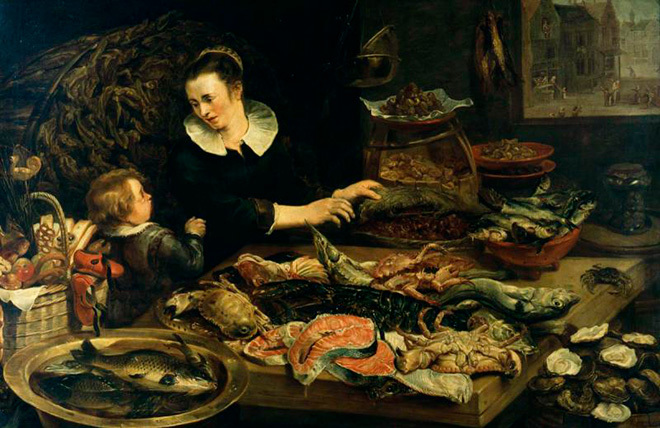 Frans Snyders. Ribna shop. 1616 rik
Frans Snyders. Ribna shop. 1616 rik A handguard with a lad, mi bachimo, a cat with a gift, yak vin trimmed until the Day of St. Nicholas In Catholicism, the Day of St. Nicholas is accepted as the 6th breast. It’s sacred for children, as for the Rizdvo, to give gifts to children.... On the price, tie the tied to the cat dere-vyan-ni red pigtails. Krym malt, fruit and gorіkhіv, in the cat to lie ryzki - like a stretch on vikhovannya "batog and gingerbread". The snake of the cat is talking about the joy and touch of human life, which constantly dares to dare one one. The woman will explain to the child that the hearing children will get the gifts, and the filthy children will get it. The slammer came up in the zhahu: he was thinking about those who replace the malt with a thunderbolt. On the right, there is a bachimo open hole, in which it is possible to spread a small area. A group of children is standing by the windows and radiantly hanging out on the balconies. The jester is an inadequate attribute of the folk Christmas celebrations.
Still life with a dinner table
Among the numerous options for serving the tables on the canvases of Dutch masters are bacimo bread and pies, peas and lemon, cowbass and shinky, lobster and crayfish, gravy with oysters, fish or empty shells. The zest of still life is possible in the presence of a set of objects.
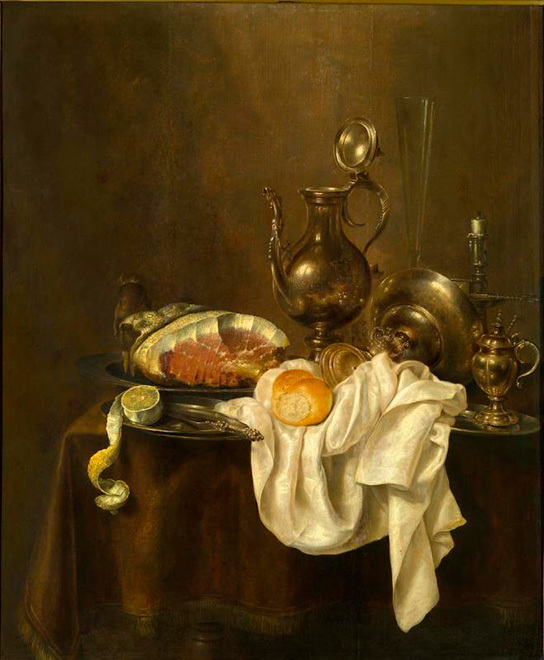 Gerrit Willems Head. Shinka and common dishes. 1649 rik sovereign museum imaginative mystery im. A.S. Pushkina
Gerrit Willems Head. Shinka and common dishes. 1649 rik sovereign museum imaginative mystery im. A.S. Pushkina In the picture by Gerrita Willems Hedi Gerrit Willems Head(1620-1702) - the author of still life and synonyms of the artist Willem Klas Hedi. mi bacimo a dish, glechik, a high-pitched cell and thrown over a vase, girchichnytsya, okist, winter servetka and lemon. Tse of traditional and love typeset Khedi. The rosetting of objects і їх vibіr non-viscous. Small dishes symbolize earthly wealth and goodness, shank - fleshly contentment, gripping on a viewer and sour in the middle of a lemon. The candle went out, in order to the loneliness and the quickness of the human sensation, the disorder on the table - to the ruin. A high-pitched glass-"flute" human life, І at the same hour symbolizes peace and in the minds of people to control their habits. In general, in the whole still-life, as in the bagatokh іnshіd "snіdankas", the theme of marnoti marnot and the lack of eyesight of earthly malts is played behind other objects.
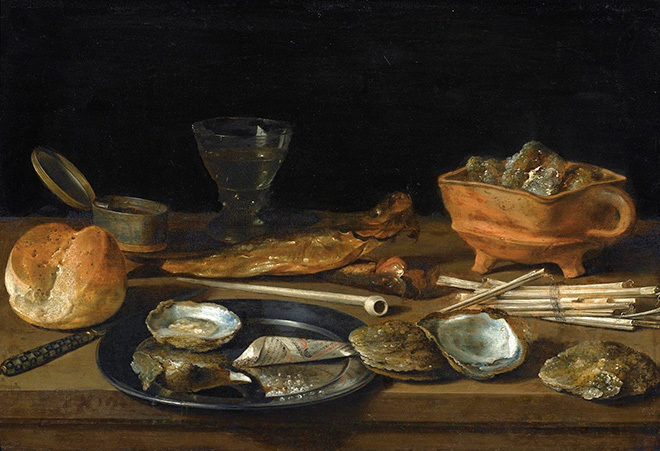 Peter Klas. Still life with brazier, oyster, oysters and smoking pipe. 1624 rik Sotheby's / Private Zbori
Peter Klas. Still life with brazier, oyster, oysters and smoking pipe. 1624 rik Sotheby's / Private Zbori A great part of the images of objects in the still life of Peter Klas Peter Klas(1596-1661) - Dutch painter, author of desolate still lifes. The order of Kheda is imbued with the master of the Harlem school and still life with geometric monochrome paintings. are erotic symbols. Oysters, pipe, wine go up to short and sumptuous meals. But there is only one option for reading a still life. We will be astonished at the image from the perspective. So, shells are a symbol of the permanency of flesh; the pipe, for the help of which they didn’t only smoke, but saw miles of bulbs, is a symbol of raptor death. A fellow Klas, a Dutchman sings by Willem Godschalk van Focke-Borch, at the verse "My hope is tse dim" he wrote:
Yak can be seen, buttya is similar to a pipe's pipe,
And in what sense - me, right, uncomfortable:
One is deprived of viterets, іnshe is deprived of dimok. Per. Evgeniya Vitkovskogo
Those shvidkoplinnosti of the human being against the backdrop of the immortality of the soul, and the signs of the loneliness of the raptus appear as symbols of the spa-sennya. Khlib and the curses of the cells with wine in the background associate with the soul and blood of the Mother of God and apply to the sacrament of the sacrament. Oseledets - another symbol of Christ - nagadu about food and food. And the opening of shells with oysters can change their negative meaning on the right side of the street, meaning the human soul, as I have come from this place and I am ready to enter into life.
It is unobtrusive to talk about people who can choose between spiritual and temporal and earthly Preceding.
Vanitas, abo "Vcheniy" still life
The genre of the so-called "vcheny" still life is called vanitas - in Latin it means "suєta suєt", in other words - "memento mori" ("remember about death"). This is an intellectual view of a still life, alegoria of vichnosty mystery, the perceptibility of earthly glory and human life.
 Yuria van Streck. Vanity. 1670 rik State Museum of Educational Mistresses IM. A.S. Pushkina
Yuria van Streck. Vanity. 1670 rik State Museum of Educational Mistresses IM. A.S. Pushkina Sword and Sholem with a pink plume in the picture by Juriana van Streck Yuria van Streck(1632-1687) - Amsterdam artist, visualized with his still lifes and portraits. vk-zuyut on the speed of earthly glory. Myslivskyi rіg symbolizes bagacy, as it is ill-fated to take with you in life. The "vchenikh" still lifes often have images of critical books, or it is not at all bad to lie on the walls with writing. The stench is not only to think about imaginary objects, or even allow the vicarists to use them for the signs: read the sidelines or the viconati are written down in the musical score of music. Van Streck z-Brasil the sketch of the boy's head and I will open the book: the whole tragedy of Sophocles "Elektra", translated into Dutch. Imagine the idea of those who art is essential. Ale the sides of the book are folded up, and the little ones are pummeled. There were some signs of the sentiment that I could pull on those who would not be able to see a mystery in death. Talking about the inevitability of death is the skull, and the axis is wrapped around the spike, symbolizing hope for resurrection and life. Until the middle of the 17th century, the skull, entwined with a flimsy ear of green ivy, became a viscous subject for images in still lifes in the style of vanitas.
